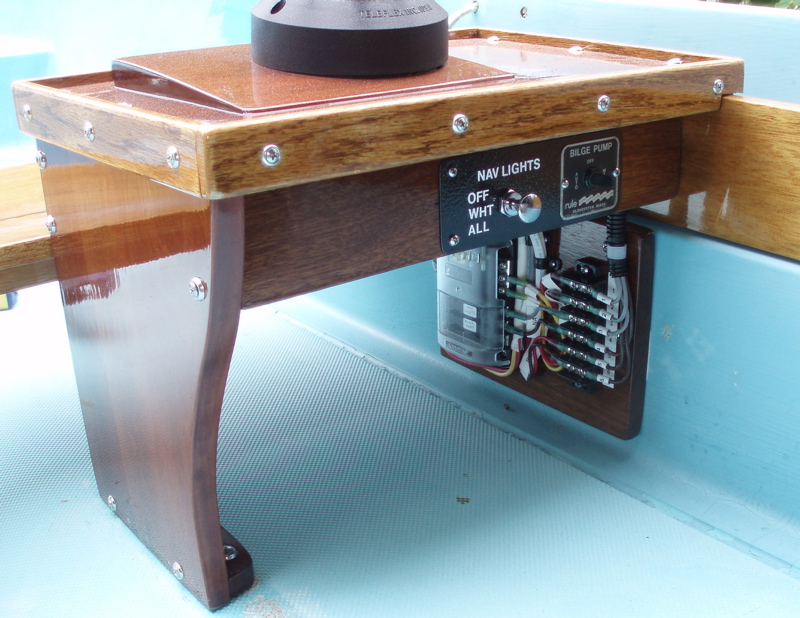Page 1 of 1
Power Distribution on 13-foot Skiff
Posted: Fri Apr 02, 2021 10:45 pm
by pollyjean123
I recently purchased a 1986 Super Sport 13. I need to re-wire the navigation lamps and the sump pump.
A [Blue Sea Systems] ST Blade Fuse Block with six circuits and negative bus and cover has been recommended to distribute electrical power to the accessories.
Q1: is using a secondary power distribution center the best method to provide power at the helm for accessories?
[Moved to SMALL BOAT ELECTRICAL for discussion and archiving.--Moderator]
Re: Power Distribution on 13-foot Skiff
Posted: Sat Apr 03, 2021 11:43 am
by Tom Hemphill
Below you can see the wiring method I used on my 1966 13-foot Sport:

- Fig. 1. Blue Sea Systems Seas ST fuse block on 13-foot open skiff
- electrical_panel.jpg (220.54 KiB) Viewed 9292 times
The 10-AWG conductor supplying power to the fuse block was protected with an in-line fuse near the battery.
Re: Power Distribution on 13-foot Skiff
Posted: Sat Apr 03, 2021 11:57 am
by pollyjean123
The wiring in Figure 1 looks great and appears to be well done. Thanks for sharing your work.
Why was a power distribution panel with terminal AND a terminal block used?
Isn't just need one set of terminals needed, not two?
Re: Power Distribution on 13-foot Skiff
Posted: Sat Apr 03, 2021 4:14 pm
by Tom Hemphill
Thank you for the compliment.
The second terminal block provides a single disconnect point for all items attached to the console for ease of maintenance.
Re: Power Distribution on 13-foot Skiff
Posted: Tue Apr 06, 2021 10:30 am
by jimh
pollyjean123 wrote:Q1: is using a secondary power distribution center the best method to provide power at the helm for accessories?
Even on a small 13-foot boat, electrical power should be distributed from a secondary panel, not by use of multiple connections directly to the battery terminals.
The Blue Sea Systems fuse panels with negative bus and covers are a good method for distributing electrical power as long as they are protected against intrusion of water from splash or spray. They are not designed for exposure to splash or spray.
Re: Power Distribution on 13-foot Skiff
Posted: Tue Apr 06, 2021 10:33 am
by jimh
pollyjean123 wrote:Why was a power distribution panel with terminal AND a terminal block used?
Isn't just need one set of terminals needed, not two?
It appears that the wiring includes some intermediate circuit elements such as switches between the terminals on the power distribution panel on the left in Figure 1 and the terminal wiring strip on the right. The wiring may be laid out so the console can be removed from the boat while the power distribution panel remains in place by disconnecting the six wires that go to the six terminals on the right.
Re: Power Distribution on 13-foot Skiff
Posted: Wed Apr 07, 2021 7:39 pm
by PatSea
[Blue Sea Systems] has a new product: a water-resistant fuse block, part number 4056.
I used it on my 13-footer. It is a good product.
Re: Power Distribution on 13-foot Skiff
Posted: Thu Apr 08, 2021 7:41 am
by jimh
PATSEA--I don't see any Blue Sea Systems product with part number 4056. I think that number is wrong. But I like the concept of a Blue Sea Systems water-resistant fuse panel.
I searched at Blue Sea Systems and found they have a new product, a water-resistant fuse panel, that is part number 5056. This component looks appropriate for use in an open skiff boat for distribution of electrical power. The MSRP is about $44. While it has only four branch circuits, for use on a 13-foot open skiff that should be sufficient for accessories.
Like many Blue Sea System products, the model 5056 water-resistant fuse panel is very nicely designed. It has sealing glands for the electrical conductors to pass through to enter the enclosure.

- Fig. 2. BLUE SEA SYSTEMS fuse block 5056.
- 5056.jpg (14.96 KiB) Viewed 9155 times
More information at:
https://www.bluesea.com/products/5056/ST-Blade_Water-Resistant_Fuse_Block
Re: Power Distribution on 13-foot Skiff
Posted: Thu Apr 08, 2021 10:23 am
by jimh
Regarding accommodation in electrical wiring for devices that are anticipated to need frequent removal or that will be fabricated as separate assemblies and then joined electrically upon installation: the most common method to provide for a simple disconnect between electrical cables is to use a connector.
Regarding terminal strips: on some types the screw fasteners are intended to remain captivated in the threaded holes on the terminal strip. This means a FORK terminal must be used to make connection to the terminal strip. Generally a RING terminal is preferred. If a terminal strip must be used, check the screw fasteners to see if they can be unthreaded completely from the terminal strip to allow use of a RING terminal. Also, in situations with vibration present, as will occur in a small boat, there should be lock washers used. Typically a star-washer is used.
A connector is really a much better solution than a terminal strip when frequent disconnections are anticipated. With regard to the GENDER of the contacts, any pole of any connector in which there is a SOURCE of electrical power should be provided with a socket (female) contact. There should not be any plug or pin (male) contacts exposed with power on them when a connector is unmated.